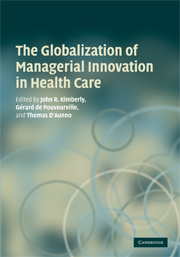Book contents
- Frontmatter
- Contents
- List of figures
- List of tables
- List of contributors
- Acknowledgements
- Introduction
- 1 Origins of DRGs in the United States: A technical, political and cultural story
- 2 Casemix in the United Kingdom: From development to plans
- 3 Casemix implementation in Portugal
- 4 From naïve hope to realistic conviction: DRGs in Sweden
- 5 Casemix in Denmark
- 6 DRGs in France
- 7 Introduction and use of DRGs in Belgium
- 8 DRGs in Germany: Introduction of a comprehensive, prospective DRG payment system by 2009
- 9 Casemix in Switzerland
- 10 The first decade of casemix in Italy
- 11 Casemix development and implementation in Australia
- 12 Diagnosis procedure combination: The Japanese approach to casemix
- 13 Casemix in Singapore
- 14 Experiences with the application of the DRG principle in Hungary
- 15 Casemix systems – past, present, and future: The Canadian experience
- 16 Conclusions: The global diffusion of casemix
- Index
7 - Introduction and use of DRGs in Belgium
Published online by Cambridge University Press: 24 February 2010
- Frontmatter
- Contents
- List of figures
- List of tables
- List of contributors
- Acknowledgements
- Introduction
- 1 Origins of DRGs in the United States: A technical, political and cultural story
- 2 Casemix in the United Kingdom: From development to plans
- 3 Casemix implementation in Portugal
- 4 From naïve hope to realistic conviction: DRGs in Sweden
- 5 Casemix in Denmark
- 6 DRGs in France
- 7 Introduction and use of DRGs in Belgium
- 8 DRGs in Germany: Introduction of a comprehensive, prospective DRG payment system by 2009
- 9 Casemix in Switzerland
- 10 The first decade of casemix in Italy
- 11 Casemix development and implementation in Australia
- 12 Diagnosis procedure combination: The Japanese approach to casemix
- 13 Casemix in Singapore
- 14 Experiences with the application of the DRG principle in Hungary
- 15 Casemix systems – past, present, and future: The Canadian experience
- 16 Conclusions: The global diffusion of casemix
- Index
Summary
A brief history of casemix systems in Belgium
All Belgian citizens are today covered by the social security system (following the Bismarck model), which is mainly financed through employment-related social contributions and general taxation. The health care system is regulated by the state and managed by INAMI (the National Institute against Illness and Disability). In INAMI, mutualities and representatives of medical professionals negotiate medical services, such as procedures and drugs, included in the nomenclature. For each service, a national fee and percentage of reimbursement is determined. Fees cover full costs and are owed to the physician, who is paid by service for ambulatory care, outpatient and inpatient care.
The Ministry (Federal Public Service) of Public Health defines the price of a day's stay for each hospital, based upon its infrastructure, accommodation and nursing care (45 percent of hospital financing). This price is based on the advice of several committees, including members of the hospital administration, physicians, and financial partners.
Physicians' activities in hospitals are covered by the reimbursement of fees for services (41 percent of hospital financing) and drugs by fees (14 percent). Inside each hospital, physicians negotiate with the medical and financial managers to determine the portion of their fees retained for overhead costs (equipment, materials, infrastructure, worker s, etc.). This open hospital financing system (by day and by service), which operates without a predetermined budget, has generated a rapid increase in the number of days, medical services and procedures performed, resulting in an exponential growth in the overall cost.
- Type
- Chapter
- Information
- The Globalization of Managerial Innovation in Health Care , pp. 144 - 152Publisher: Cambridge University PressPrint publication year: 2008



